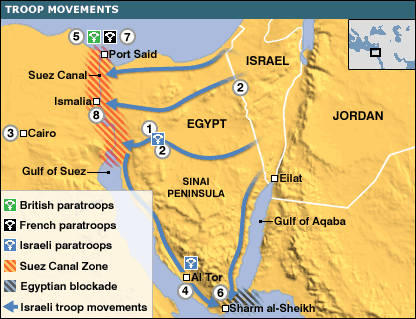The Suez/Sinai War of 1956
A brief summary of the campaign:
In 1956, three of the Twentieth Century’s most dominant forces came together in a short, violent clash in the Egyptian regions known as the Suez Canal and the Sinai Peninsula. These three forces, (or, to use a literary term, themes), were: Nationalism, the Cold War and the Arab-Israeli conflict. Egypt and other Arab nations had recently gained full independence from the empires controlled by European powers such as Great Britain and France. These young nations with ancient cultures and histories strove to gain economic and military sufficiency while asserting their political rights as free peoples. The Cold War struggle between the mostly democratic and capitalist West against the Communist East dominated by the Soviet Union and China both helped and hindered the Nationalist goals of many African and Asian countries. For example, Egypt sought foreign aid in building the Aswan Dam project which would control the wild Nile River. The United States and Britain, major players in the West, declined to help Egypt because of her political and military ties to the Soviet Union. The Soviets eagerly rushed in to aid Egypt. After this, Egypt came to be considered a friend of the Soviets, and a nation not overly friendly to the West. In this way, the Cold War affected the young nation of Egypt and her relations with the rest of the world. The Arab-Israeli conflict began in 1948 and caused Egypt and Israel to be bitter foes until 1979. The second war between these Middle East neighbors took place in 1956.

On October 29, 1956, Israeli troops invaded Egypt’s Sinai Peninsula and quickly overcame opposition as they raced for Suez. The next day, Britain and France, following their part of the script, offered to temporarily occupy the Canal Zone and suggested a 10 mile buffer on either side which would separate the Egyptian forces from the Israelis. Nasser of course refused, and on October 31, Egypt was attacked and invaded by the military forces of Britain and France. In response to these developments, the Soviet Union, which at the time was ruthlessly suppressing an anti-Communist uprising in Hungary, threatened to intervene on Egypt’s behalf. President Eisenhower of the United States pressured Britain, France and Israel into agreeing to a cease-fire and eventual withdrawal from Egypt. The United States, caught by surprise by the dual invasions, was more concerned with the Soviet war in Hungary and the Cold War than with Britain and France’s dealings involving Suez. The last thing President Eisenhower wanted was a wider war over Suez. The war itself lasted for only a week, and invading forces were withdrawn within the month. As a result, Egypt now firmly aligned herself with the Soviet Union, which armed Egypt and other Arab nations for the continuing struggle against Israel.
Suez War Maps and Pictures:

Map of the Sinai Peninsula and the Suez Canal region during the 1956 war.

Israeli Commander Moshe Dayan in the Suez Canal region during the 1956 war.
Casualties in the Suez War:
Israel:
189 killed,
899 wounded,
4 taken prisoner
Egypt:
vs. French/British forces–
650 killed,
900 wounded,
185 taken prisoner
vs. Israeli forces–
1,000 killed,
4,000 wounded,
6,000 taken prisoner
France:
10 killed,
33 wounded
Great Britain:
16 killed,
96 wounded
General Links:
Arab-Israeli Conflict–The Hutchison Encyclopedia article on the Arab-Israeli Wars.
American Reaction to the Suez War–Places the Suez Crisis and War within the proper context of world affairs at the time and explains America’s reactions.
Suez 1956–Very good essay on the Suez Crisis written by University of San Diego student Chris Leininger.
The Suez War of 1956 : Table of Contents— Part of the Jewish Student Online Research Center (JSOURCE).
Anglo-French Attack on the Suez Canal
Suez Canal War (1956)–A web page on French aviation details some of the French units involved in the war.
Israeli Invasion of the Sinai
1956 Sinai Campaign–Article on the Anti-Defamation League website.
Map of the 1956 Sinai Campaign
Egyptian President Nasser
Speech by Nasser: Sept. 15, 1956–Nasser’s speech on the Suez Canal and negotiations with Britain and France.
Sources:
Phillips, Charles, and Alan Axelrod.Encyclopedia of Wars. 1st ed. New York: Facts on File, 2004.
Marshall, S.L.A.Sinai Victory: Command Decisions in History’s Shortest War: Israel’s Hundred-Hour Conquest of Egypt. Morrow, New York, 1958.
Herzog, Chaim.The Arab-Israeli Wars: War and Peace in the Middle East from the War of Independence through Lebanon. Vintage Books, New York, 1982.
Barker, A.J.Arab-Israeli Wars. Hippocrene Books, New York, 1980.
Copyright © 1998-2023 History Guy Media; Last Modified 11.15.23
“The History Guy” is a Registered Trademark.
